See the past, present, and future through Nagoya architecture.
Japan has some fascinating architecture. Kyoto is famous for its traditional temples and buildings, while Tokyo is renowned for its ultramodern cityscapes and awe-inspiring skyscrapers that dominate its skyline.
Nagoya is very much a mixture of the two. It is quickly developing new high-rise apartment buildings and offices, but it’s not just flashy apartments that help create Nagoya’s impressive array of buildings.
Read more to discover some of the city’s traditional and modern architecture and make sure to check out the links for some of the locations mentioned in this post!
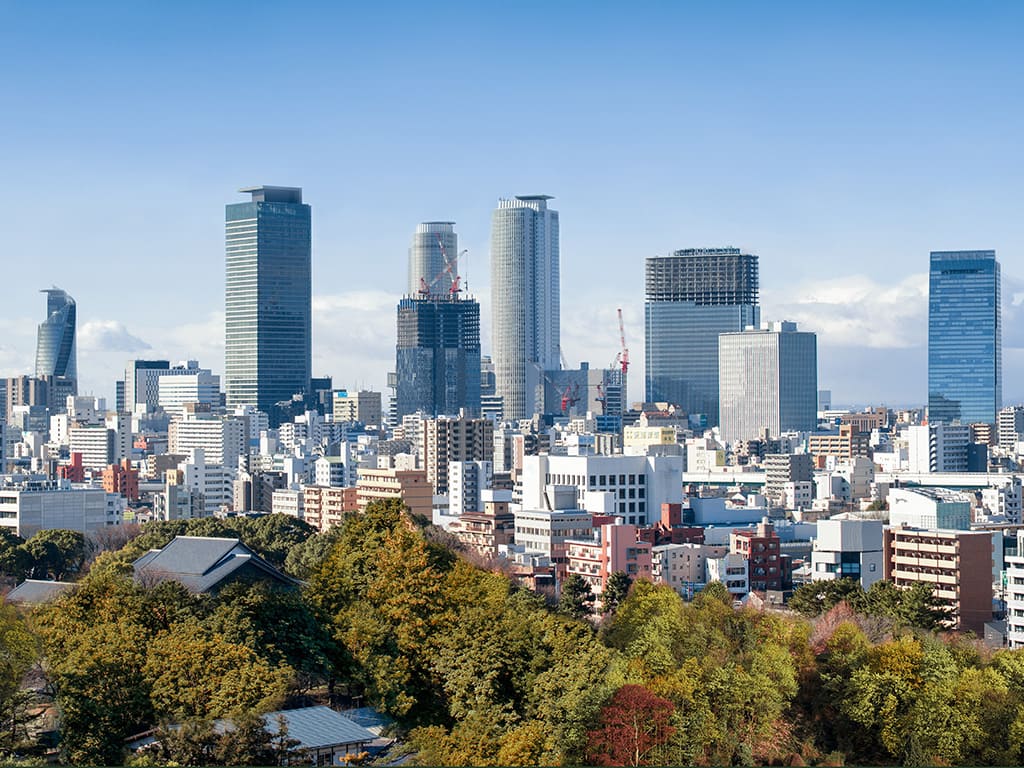
Article Contents
Remnants of Nagoya’s Ancient Days
Nagoya was heavily shaped during Japan’s Edo Period (1603 – 1867) when the country closed its doors to the outside world. During this time, Tokugawa Ieyasu, the unifier of the country, moved the region’s capital from Kiyosu to Nagoya. Nagoya has remained the capital of Aichi ever since, becoming the most prosperous city in the area. Much of Nagoya’s Edo Period architecture remains to be enjoyed to this day.
Tokugawa Ieyasu was born in Okazaki, which is a 45 minute train ride away. For more information about this legendary figure, check out our Okazaki City Guide, or join us for a guided tour of the city!
Nagoya Castle

The eponymous castle has stood for about four centuries, marking the official beginning of Nagoya’s position as the capital of the Owari region (now western Aichi). It has undergone many renovations throughout the years. In style, it remains nearly identical to what it would have looked like. However, what we see today is not wholly what once was.
The castle palace was bombed during World War II, and had been rebuilt from its remains using many of the same techniques that would have been used hundreds of years ago. Nowadays, the castle and its grounds are a museum with exhibits and events that teach all visitors the long history of Nagoya and its famous castle. The remnants of the original castle can be seen in great stone walls that mark its old moat.
Check out our article for more information about Nagoya Castle, or join us for a tour.
Nagoya Castle (名古屋城)
Entry Fee: Adults: 500 yen; Adults over 65: 100 yen, Children: free
Opening Hours: 9:00 – 16:30
Address: 1-1 Honmaru, Naka Ward, Nagoya, Aichi 460-0031
Website | Google Maps
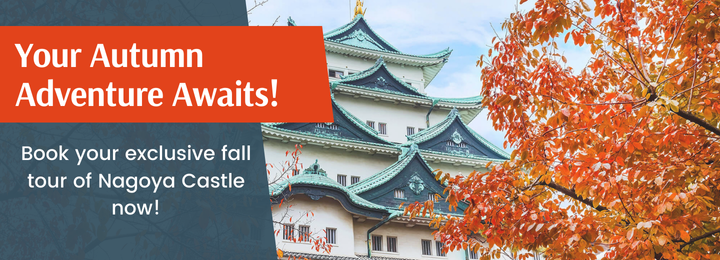
Arimatsu

Even today, Nagoya is still described as a “hub” due to its positioning between Tokyo and Osaka/Kyoto. Historically, Nagoya has played that role as a convenient stop along the Tokaido Road, along with a few other towns that have since been become part of the greater Nagoya area.
Possibly the most famous of these towns is Arimatsu, which today is part of Nagoya’s Midori ward southwest of the city center. This small town is known for its traditional buildings that have been maintained for hundreds of years, along with its age-old tie-dying technique.
Japan’s Taste for Western Culture
After Japan opened its doors again to foreign visitors, the country underwent great changes socially and economically. As western culture began to permeate throughout Japan, its cities began to take a new shape and style reflecting what was considered the much more sophisticated western world. This shift in style can be seen in Nagoya, particularly on the northeast side, as you stroll down the Cultural Path.
Yokiso

A great example of this shift can be found in Yokiso. Yokiso is located in Kakuozan, in the Chikusa ward east of downtown Nagoya. Kakuozan is known for its more traditional architecture, but if you visit the Yokiso just next to the Nittaji temple, you’ll find a villa that is a great combination of western and Japanese architecture dating from the early 20th century.
Built by the 15th president of the famous department store Matsuzayaka, the buildings on the premises show typical early 20th-century western decor in a very Japanese setting.
Find out more about Yokiso and Kakuozan in general here.
Yokiso (揚輝荘)
Entry Fee: Adults: 300 yen, Junior High Students and those over 65: 100 yen
Opening Hours: 9:30 – 16:30. Closed Mondays or the following weekday if it’s a national holiday.
Address: 2-5-17 Ho-cho, Chikusa Ward, Nagoya, Aichi
Website (Japanese only) | Google Maps
Nagoya City Archives and Museum

Redbrick is not commonly used in Japan nowadays, but was very popular at the start of the Meiji period as the main material for buildings in the UK and America. The Nagoya City Archives and Museum was built in the early 20th century to emulate the Baroque architectural styling of Europe and was used as a courtroom up until the end of the 1970s.
It is now a free museum that provides not only the history of Nagoya, but a popular backdrop for newlyweds. The building is surrounded by a red brick wall that surroubds a pleasant green area that shows off an array of cherry blossom trees throughout the Hanami (flower viewing) season.
Nagoya City Archives and Museum (名古屋市市政資料館)
Entry Fee: Free
Opening Hours: 9:00 – 17:00. Closed Mondays.
Address: 1-3 Shirakabe, Higashi Ward, Nagoya, Aichi 461-0011
Website (Japanese only) | Google Maps
Nagoya City Hall

Nagoya City Hall is a fantastic structure that thankfully survived the WWII bombing, unlike its unfortunate neighbor Nagoya Castle. We’ve mentioned the blending of East and West a few times already, but nowhere is it seen quite so clearly as Nagoya City Hall. This impressive structure shows off both architectural types with its heavy stone walls and traditional western-style windows, with heavy Japanese-style roofing.
It is unique in that it still operates under its original purpose as a governmental building while many others now act as tourist attractions of historical significance.
Nagoya City Hall (名古屋市役所)
Opening Hours: 8:45 – 17:15. Closed Saturdays and Sundays.
Address: 3-1-1 Sannomaru, Naka Ward, Nagoya, Aichi 460-8508
Website (Japanese only) | Google Maps
Cultural Path Houses
Nagoya’s Higashi (east) ward is home to many historical buildings along what is called Bunka No Michi (The Cultural Path). The area from Nagoya castle to Tokugawaen was where many low- and middle-ranking Samurai lived in the Edo period. Later, successful journalists, artists, missionaries, etc. came in during the Meiji period after the abolition of the Samurai. On this path, you can find old Samurai houses alongside early 20th-century western architecture.
Hyakka Hyakuso

First up on our list for the Cultural Path is Hyakka Hyakuso (literally “a hundred flowers, a hundred weeds”) that is named after an important folding screen that was founded in the Tokugawa Art Museum of the same name. It is a traditional Japanese house built circa 1920 and was the residence of the Okaya family, the founder of Okaya Koki, an independent trading company that handles steel and machinery. Unlike the other buildings on Nagoya’s Cultural Path, it is still owned by the original family, not Nagoya city.
It is currently used as a multi-purpose venue that can be rented out to users. The building’s appeal is not only its style but also the garden that comes with it, offering a peaceful retreat in an otherwise busy area and a Tatami room with a tea ceremony display that offers a free tea service and coffee and sweet snacks along with books about flowers and gardens.
Hyakka Hyakuso (百花百草)
Entry Fee: Adults: 500 yen, Junior High and Elementary Students: 200 yen, Children Under Elementary: free
Opening Hours: 10:00 – 16:00 Wednesday to Saturday. Closed from Sunday to Tuesday.
Address: 4-91 Shirakabe, Higashi Ward, Nagoya, Aichi 461-0011
Website (Japanese only) | Google Maps
Futaba Museum

Another one to add to the list of East meets West, the Futaba Museum wears a striking orange roof atop a western-style stone exterior and stained glass windows that look into a much more Japanese interior. It was home to Sadayakko Kawakami, the “first Japanese actress” giving it an extremely important cultural heritage to not only Nagoya but Japan as a whole.
Futaba Museum (二葉館)
Entry Fee: Adults: 200 yen, Junior High School and under: free.
Opening Hours: 10:00 – 17:00. Closed Mondays.
Address: 3-23 Shumokucho, Higashi Ward, Nagoya, Aichi 461-0014
Website | Google Maps
Shumokukan

Once the house of famous Japanese ceramic exporter Tamesaburo Imoto, Shumokukan is a snapshot of Japan’s Taisho era (1912-1926) as it transitioned into the much longer Showa period (1926 – 1989). This part of Nagoya was extremely active in the ceramics industry with up to 80% of ceramic painting done here in Nagoya city.
Although its surroundings have changed considerably in the past 100 years, it remained an actual residence up until 2002, after which it was eventually bought by Nagoya city and now is marked as a landmark of cultural significance. The building and its grounds evoke a strong sense of nostalgia for many and its garden changes with the seasons making it a great place to visit any time of the year.
Shumokukan (撞木館)
Entry Fee: Adults: 200 yen, Junior High School and under: free, Nagoya residents of 65 and over: 100 yen. Discounts are available for large groups and a joint ticket with Futaba Museum.
Opening Hours: 10:00 – 17:00. Closed Mondays (or the following day when a national holiday)
Address: 2-18 Shumokucho, Higashi Ward, Nagoya, Aichi 461-0014
Website | Google Maps
Former Toyoda Sasuke House

While perhaps not the most famous of the Toyodas, Sasuke was the brother of Sakichi, known as the “king of inventors” (and also the founding father of a well-known car manufacturer called “Toyota” that you may have heard of!). His house is the only one remaining in the area, offering a fantastic example of how the rich lived during the early 20th century. It has both a western-style and Japanese-style house for you to enjoy showing a real-time comparison of the two styles.
Former Toyoda Saskue House (旧豊田佐助邸)
Entry Fee: Free
Opening Hours: 10:00 – 15:30. Closed on Mondays (or the following day when a national holiday)
Address: 3-8 Chikaramachi, Higashi Ward, Nagoya, Aichi 461-0018 Aichi
Website (Japanese only) | Google Maps
Former Haruta Tetsujiro House

Just next door to the famous Toyoda residence, we have the residence of another successful ceramic merchant, Haruta Tetsujiro. Similar in style to Toyoda Sasakue’s residence, the grounds have both a Western and a Japanese style house, the former of which is now used as a French fusion restaurant on the ground floor that offers tours of the building on request. It was also used as a headquarters for the US military after the end of WWII (1947 – 1951).
Former Haruta Tetsujiro House (旧春田鉄次郎邸)
Entry Fee: Free
Opening Hours: 10:00 – 15:30. Closed Mondays, Fridays, and Sundays.
Address: 3-6 Chikaramachi, Higashi Ward, Nagoya, Aichi 461-0018
Website (Japanese only) | Google Maps
Chikaramachi Catholic Church

Established in 1888 by French Catholic missionary Fr. Augustin Tulpin and doctor Shusai Inoue, it is the oldest church in Aichi. With its very modest blend of Japanese and western architecture, it certainly stands out from its surroundings that are now far from what this area would have looked like at the end of the 19th century. The church has gone through a lot of reconstruction and expansion over the years and very much like the Nagoya City Hall, it still fulfills its primary function as a church and holds mass every Sunday (Japanese only).
Chikaramachi Catholic Church (カトリック主税町教会)
Entry Fee: Free
Opening Hours: 9:30 – 16:30 Mon, Wed, Fri, Sat.
Address: 3-33 Chikaramachi, Higashi Ward, Nagoya, Aichi 461-0018
Website | Google Maps
Museum Meiji Mura (Inuyama)

Meiji Mura is a real feat of imagination and a treat for history buffs. This 250-acre area of land is dedicated to the preservation of buildings from the Meiji era and the start of the Taisho era, whereby buildings from all over the country have been painstakingly deconstructed and then reconstructed here in Aichi to protect them from an ever-changing taste of architecture in Japan.
This open museum has a wide array of buildings, from old banks to prison cells. It’s located next to the pleasant Lake Iruka and its surrounding countryside.
Visitors can spend the day leisurely walking around this wide area, or alternatively hop on a Meiji era-style bus. Meiji Mura also offers TV producers a great location to film period dramas, and is perfect for amateurs looking for a good shot.
Meiji Mura (明治村)
Entry Fee: Adults: 2,000 yen, University Students/Seniors: 1,600 yen, High School Students: 1,200 yen, Elementary Students: 700 yen.
Opening Hours: 10:00 – 17:00 (hours vary slightly by season)
Address: 1 Uchiyama, Inuyama, Aichi 484-0000
Website | Google Maps
From Past to Present and to the Future
Meiji Mura is the gatekeeper of traditional architecture that fended off the changing cityscapes in Japan, and as we will now see, Nagoya is no exception to the large-scale modernization of city architecture not only in Japan but across the globe. While many old buildings proudly remain, they are overshadowed by the great glass towers that now dominate Nagoya’s skyline and offer a lot more than museums.
Mode Gakuen Spiral Towers

Possibly the most visibly intriguing of all the buildings in Nagoya, the Spiral Tower is an educational facility comprising three schools and is located right outside of Nagoya station. As the name suggests, the tower is a twisted building that helps it stand out in the forest of buildings in this area.
Mode Gakuen Spiral Towers (モード学園スパイラルタワーズ)
Opening Hours: 10:00 – 20:00
Address: 4-27-1 Meieki, Nakamura Ward, Nagoya, Aichi 450-0002
Website | Google Maps
Dai Nagoya Building

One of the more recent additions to the Nagoya station area. This building replaced the old Dai Nagoya Building with its completion in 2015. It houses offices, restaurants, bars, and clinics with a great underground shopping street that connects to the station as well as the “Sky Garden” that offers a bit of green in the otherwise concrete jungle.
Dai Nagoya Building (大名古屋ビルヂング)
Opening Hours: 11:00 – 23:00
Address: 3-28-12 Meieki, Nakamura Ward, Nagoya, Aichi 450-6490
Website | Google Maps
Kitte Nagoya

Kitte Nagoya is a commercial building located right next to Nagoya station and along with the Dai Nagoya Building, is symbolic of a new age of success for the city of Nagoya. Below is the JP Tower, which is dedicated to providing high-quality products and restaurants for locals and travelers alike and holds special events throughout the year for visitors to enjoy.
Kitte Nagoya (キッテナゴヤ)
Opening Hours: 10:00 – 23:00
Address: JP Tower Nagoya 1-1-1 Nakamura Ward, Nagoya, Aichi 452-0002
Website | Google Maps
Misonoza

Between Nagoya station and Sakae lies Fushimi, a fast developing area. Misonoza is a Kabuki theater that is steeped in history and has evolved over the years. It used to be a simple wooden structure in the Edo period, and was rebuilt with the western style brick structure, similar to the Nagoya Archives. Now, the theater is a very modern-looking building with Edo’s Namako style walls of crisscrossed white lines that encase the entire building. It continues to be a very popular Kabuki theater today with the impressive Misanoza Tower apartment building as its backdrop.
Misonoza (御園座)
Opening Hours: 10:00 – 18:00
Address: 1-6-14 Sakae, Naka Ward, Nagoya, Aichi 460-8403
Website (Japanese only) | Google Maps
Nagoya City Science Museum

Nagoya City Science Museum is difficult to miss. If you’re walking around town and suddenly come across a big metal ball floating in the air, you’ve found it. That is Nagoya’s famous planetarium, which is the largest in the world! Next to that is the very popular science museum, which holds special events all year round. The museum gives its visitors a very hands-on experience of science, and is extremely popular with children and a perfect place to go with your family.
Nagoya City Science Museum (名古屋料学館)
Opening Hours: 9:30 – 17:00. Closed Mondays.
Address: 2-17-1 Sakae, Naka Ward, Nagoya, Aichi 460-0008 Aichi
Website (Japanese only) | Google Maps
Nagoya City Art Museum

Just across from the Nagoya City Science Museum is another quirky building that holds many artistic treasures inside. Designed by famed architect Kisho Kurokawa and built-in 1977, the Nagoya City Museum of Art is described as a piece of art itself that sits in the quiet escape from the busy city in Shirakawa Park.
The museum displays art from all over the world, such as the Mexican Renaissance, Ecole de Paris, and of course plenty of local Japanese art as well. Artwork is displayed on rotation with new displays and exhibitions happening throughout the year, so there is ample opportunity to experience this building over and over again.
Nagoya City Art Museum (名古屋市美術館)
Opening Hours: 9:30 – 17:00. Closed Mondays and open until 20:00 Fridays
Address: 2-17-25 Sakae, Naka Ward, Nagoya, Aichi 460-0008
Website | Google Maps
Nagoya TV Tower
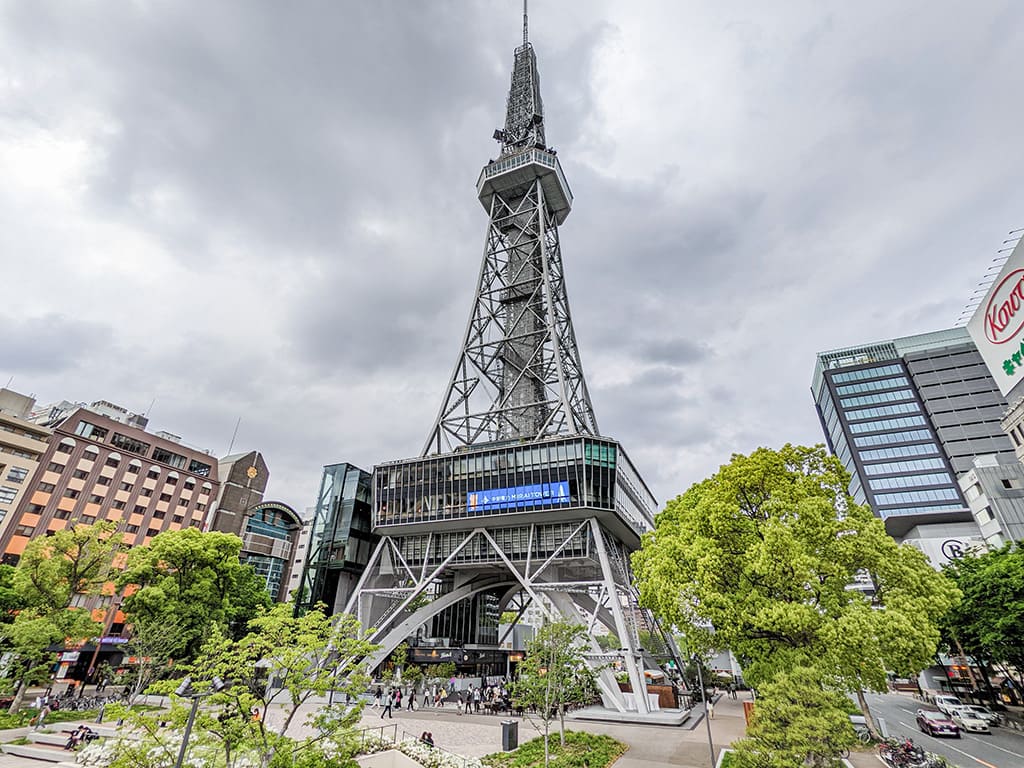
Officially named the Chubu Electric Power MIRAI TOWER but locally known simply as the TV Tower, this structure was completed in 1954 but does not feel out of place surrounded by a constantly modernizing city. With a newly reopened park under it with restaurants, shops, and bars, it has once again become a great center point of the city, popular with people of all ages and has quickly turned into an outdoor gathering spot.
The tower itself has an observatory deck, offering an amazing view of the city. It also has a restaurant, cafe, and even a small hotel. It may not be as famous as the Eiffel Tower or Tokyo Tower, but it lays claim to the title of the oldest TV tower in Japan!
Nagoya TV Tower (名古屋テレビ塔)
Entry Fee: Adults: 900 yen, Elementary/Junior High Students: 400 yen
Opening Hours: 10:99 -21:00
Address: 3-6-15 Nishiki, Naka Ward, Nagoya, Aichi 460-0003
Website | Google Maps
Oasis 21

Right next door to Nagoya TV Tower, you will see a very odd flat disc hovering above the ground, most likely with a lot of noise coming from below. This is the “Spaceship Aqua”, which is part of Oasis 21. This futuristic structure has an accessible glass roof that covers the open space below, and is often used for events such as small music festivals, cosplay competitions, pop-up markets, and even a skating rink in the winter. It also acts as a public transport hub, with a bus station and links to multiple train lines underneath. It has a variety of shops such as the popular Jump Comic shop, which sells all sorts of goods from comics such as One Piece and Naruto.
Oasis 21 (オアシス21)
Opening Hours: 10:00 – 21:00
Address: 1-11-1 Higashisakura, Higashi Ward, Nagoya, Aichi 461-0005
Website | Google Maps
Nadya Park

Outside of the main shopping area, the Nadya Park building dominates its surroundings with its impressive metallic structure. This building houses a variety of restaurants, offices, and shops, most famous of all being LOFT, which takes up nearly half the building! As you walk through the entrance, it’s hard not to be impressed by the wide-open area that stretches all the way up to the top of the building, emphasizing the sheer size.
Nadya Park (ナディアパーク)
Opening Hours: 10:30 – 20:00
Address: Sakae 3-18-1, Naka Ward, Nagoya-shi, Aichi 460-0008
Website | Google Maps
HASE-BLDG. 1

Osu is known for its oddities and this building perfectly highlights the eccentricity of that area. Created in the shape of a honeycomb, this unique facade will no doubt turn every head that walks past it. This is the first of a series of “HASE” buildings and is easily the most striking. Inside you will find some clothes shops, hair salons and even a golf simulator! Be sure to keep your eyes peeled as you wander the funky Osu streets.
HASE-BLDG. 1
Opening Hours: 11:00 – 19:00 Wed – Friday, 10:00 – 18:30 Sat – Sun, Closed Mon – Tues
Address: 3-5-13 Osu, Naka Ward, Nagoya, Aichi 460-0011
Website (Japanese only) | Google Maps
Ryoguchiya Korekiyo Higashiyama Store

If you are making your way to Nagoya’s Zoo and Botanical Garden, you’ll surely come across this unique flat-top pyramid building. The Ryoguchiya confectionery shops goes back to the early 17th century and for nearly 400 years been making sweets with the highest quality ingredients. Famous among the locals, you won’t be disappointed with their products.
Ryoguchiya Korekiyo Higashiyama Store (両口屋是清東山店)
Opening Hours: 9:00 – 18:00
Address: 4-4 Higashiyamatori, Chikusa Ward, Nagoya, Aichi 464-0807
Website (Japanese only) | Google Maps
Did you enjoy this article?
Then you might also enjoy this post: The Best Day Trips From Nagoya in Aichi Prefecture
Or check out all of our blog posts here.
Be sure to follow us on Facebook for new articles every week, and see our Instagram for pictures and stories about Nagoya!
Share your comments below or message us using any of our SNS or send us an email.
Tag us
Share your favorite building on social media and make sure to tag us on with #nagoyaisnotboring. You might even be featured on our social media account!

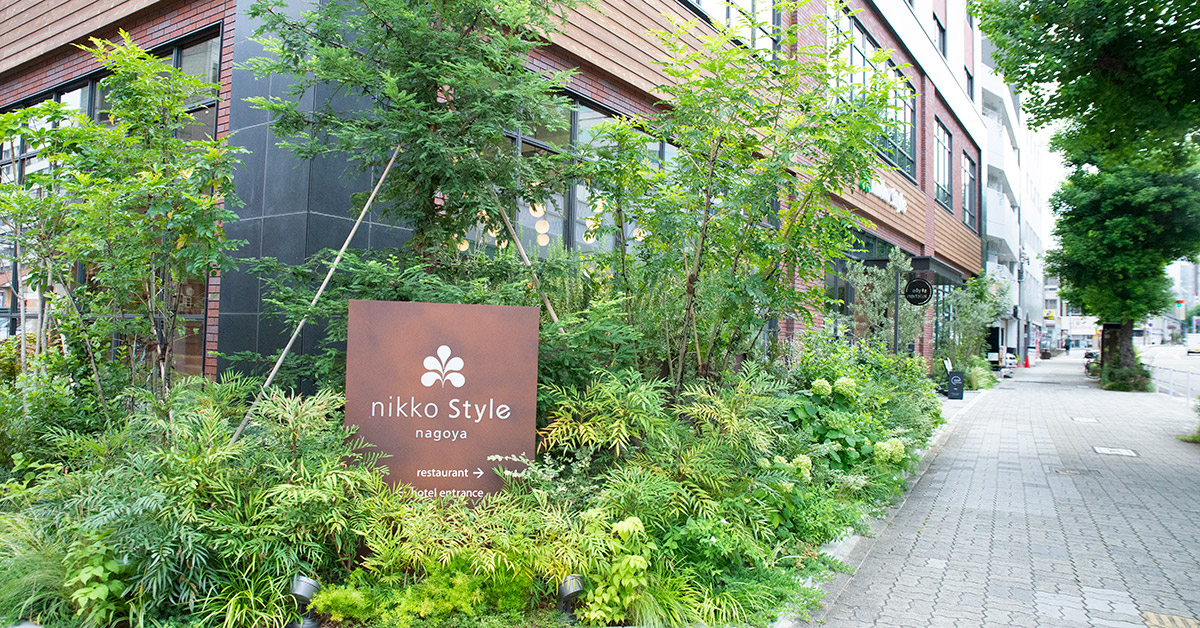
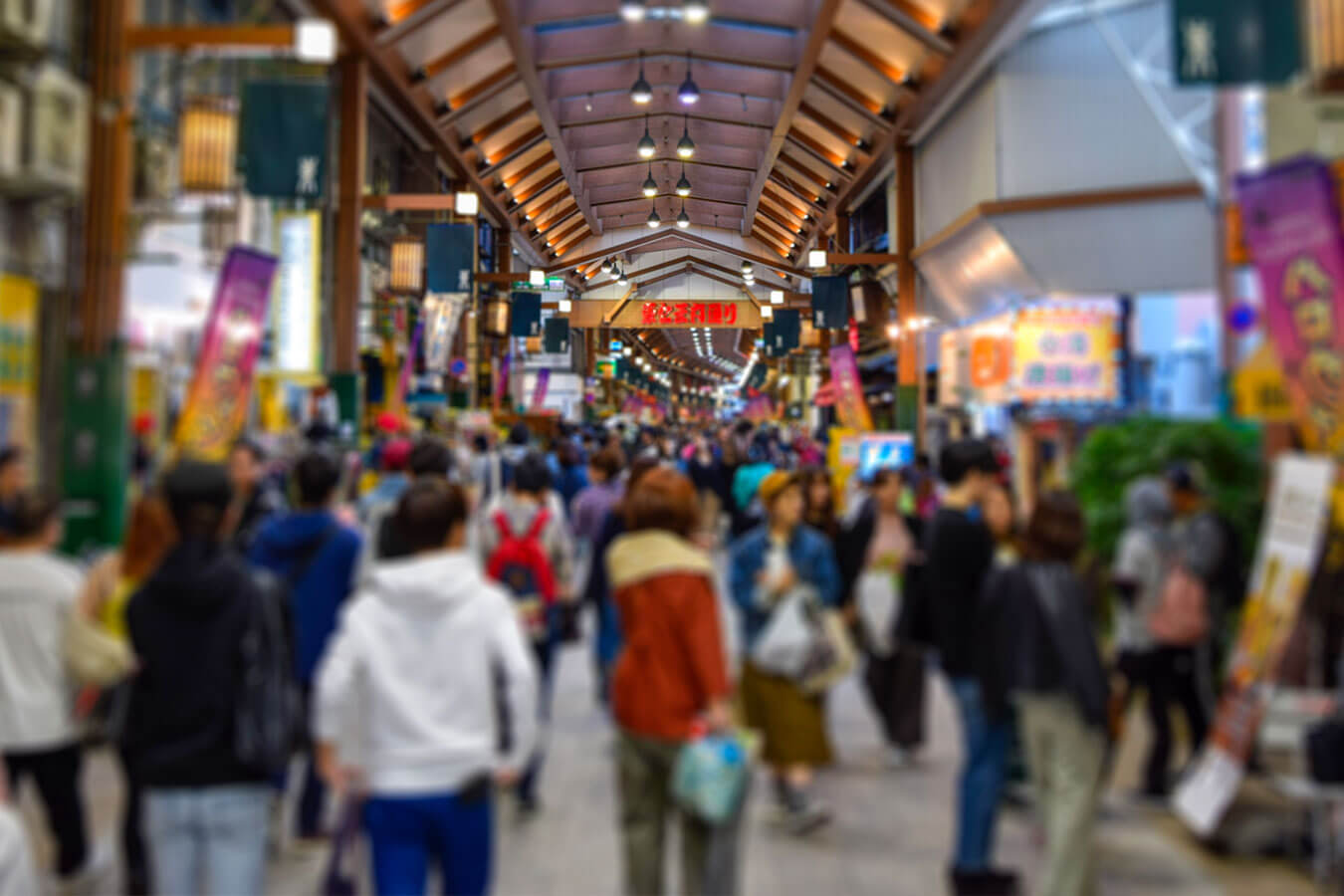


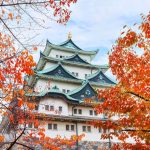
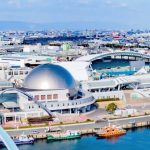

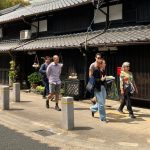
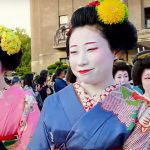
As a regular visitor to Nagoya I love these articles to look at where I have been and to find somewhere new and exciting to go next time